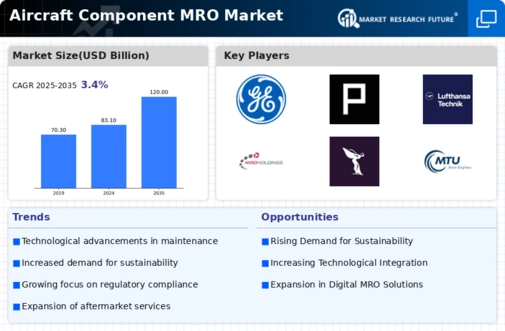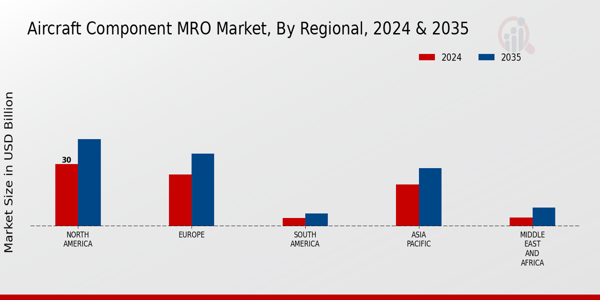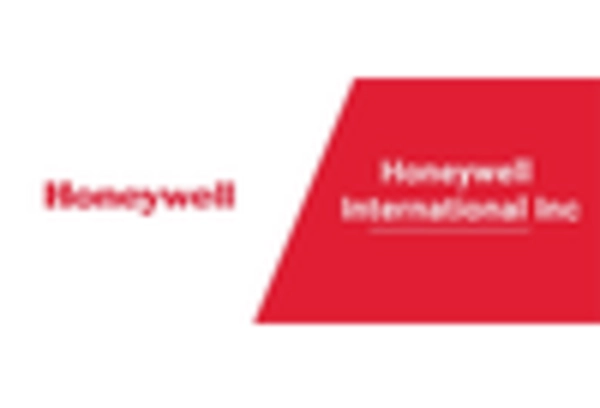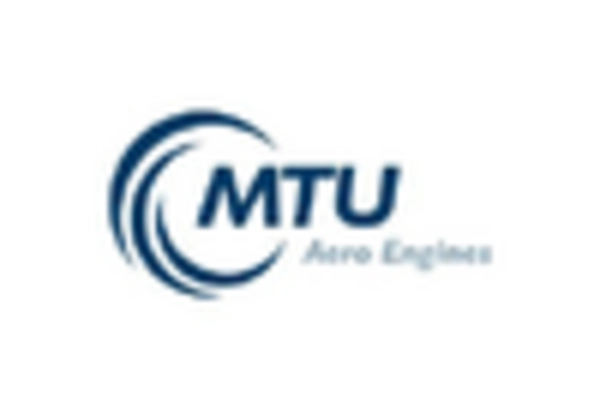-
EXECUTIVE SUMMARY
-
Market Overview
-
Key Findings
-
Market Segmentation
-
Competitive Landscape
-
Challenges and Opportunities
-
Future Outlook
-
\r\n
-
MARKET INTRODUCTION
-
Definition
-
Scope of the study
- Research Objective
- Assumption
- Limitations
-
RESEARCH METHODOLOGY
-
Overview
-
Data Mining
-
Secondary Research
-
Primary Research
- Primary Interviews and Information Gathering Process
- Breakdown of Primary Respondents
-
Forecasting Model
-
Market Size Estimation
- Bottom-Up Approach
- Top-Down Approach
-
Data Triangulation
-
Validation
-
\r\n
-
MARKET DYNAMICS
-
Overview
-
Drivers
-
Restraints
-
Opportunities
-
MARKET FACTOR ANALYSIS
-
Value chain Analysis
-
Porter's Five Forces Analysis
- Bargaining Power of Suppliers
- Bargaining Power of Buyers
- Threat of New Entrants
- Threat of Substitutes
- Intensity of Rivalry
-
COVID-19 Impact Analysis
- Market Impact Analysis
- Regional Impact
- Opportunity and Threat Analysis
-
\r\n
-
AIRCRAFT COMPONENT MRO MARKET, BY COMPONENT TYPE (USD BILLION)
-
Engine Components
-
Avionics
-
Landing Gear
-
Hydraulics
-
Fuel Systems
-
AIRCRAFT COMPONENT MRO MARKET, BY MATERIAL TYPE (USD BILLION)
-
Metal
-
Composite
-
Plastic
-
Rubber
-
Ceramic
-
AIRCRAFT COMPONENT MRO MARKET, BY SERVICE TYPE (USD BILLION)
-
Repair
-
Overhauling
-
Maintenance
-
Modification
-
Inspection
-
AIRCRAFT COMPONENT MRO MARKET, BY END USE (USD BILLION)
-
Commercial Aviation
-
Military Aviation
-
Cargo Aircraft
-
Business Jets
-
Helicopters
-
AIRCRAFT COMPONENT MRO MARKET, BY REGIONAL (USD BILLION)
-
North America
- US
- Canada
-
Europe
- Germany
- UK
- France
- Russia
- Italy
- Spain
- Rest of Europe
-
APAC
- China
- India
- Japan
- South Korea
- Malaysia
- Thailand
- Indonesia
- Rest of APAC
-
South America
- Brazil
- Mexico
- Argentina
- Rest of South America
-
MEA
- GCC Countries
- South Africa
- Rest of MEA
-
\r\n
-
COMPETITIVE LANDSCAPE
-
Overview
-
Competitive Analysis
-
Market share Analysis
-
Major Growth Strategy in the Aircraft Component MRO Market
-
Competitive Benchmarking
-
Leading Players in Terms of Number of Developments in the Aircraft Component MRO Market
-
Key developments and growth strategies
- New Product Launch/Service Deployment
- Merger & Acquisitions
- Joint Ventures
-
Major Players Financial Matrix
- Sales and Operating Income
- Major Players R&D Expenditure. 2023
-
COMPANY PROFILES
-
General Electric
- Financial Overview
- Products Offered
- Key Developments
- SWOT Analysis
- Key Strategies
-
Airbus
- Financial Overview
- Products Offered
- Key Developments
- SWOT Analysis
- Key Strategies
-
Fokker Technologies
- Financial Overview
- Products Offered
- Key Developments
- SWOT Analysis
- Key Strategies
-
Pratt & Whitney
- Financial Overview
- Products Offered
- Key Developments
- SWOT Analysis
- Key Strategies
-
Raytheon Technologies
- Financial Overview
- Products Offered
- Key Developments
- SWOT Analysis
- Key Strategies
-
AAR Corp
- Financial Overview
- Products Offered
- Key Developments
- SWOT Analysis
- Key Strategies
-
Honeywell International
- Financial Overview
- Products Offered
- Key Developments
- SWOT Analysis
- Key Strategies
-
ST Aerospace
- Financial Overview
- Products Offered
- Key Developments
- SWOT Analysis
- Key Strategies
-
Lufthansa Technik
- Financial Overview
- Products Offered
- Key Developments
- SWOT Analysis
- Key Strategies
-
HérouxDevtek
- Financial Overview
- Products Offered
- Key Developments
- SWOT Analysis
- Key Strategies
-
MRO Holdings
- Financial Overview
- Products Offered
- Key Developments
- SWOT Analysis
- Key Strategies
-
RollsRoyce
- Financial Overview
- Products Offered
- Key Developments
- SWOT Analysis
- Key Strategies
-
MTU Aero Engines
- Financial Overview
- Products Offered
- Key Developments
- SWOT Analysis
- Key Strategies
-
Boeing
- Financial Overview
- Products Offered
- Key Developments
- SWOT Analysis
- Key Strategies
-
Safran
- Financial Overview
- Products Offered
- Key Developments
- SWOT Analysis
- Key Strategies
-
APPENDIX
-
References
-
Related Reports
-
\r\n
-
LIST OF TABLES
-
\r\n
-
LIST OF ASSUMPTIONS
-
NORTH AMERICA AIRCRAFT COMPONENT MRO MARKET SIZE ESTIMATES & FORECAST, BY COMPONENT TYPE, 2019-2035 (USD BILLIONS)
-
NORTH AMERICA AIRCRAFT COMPONENT MRO MARKET SIZE ESTIMATES & FORECAST, BY MATERIAL TYPE, 2019-2035 (USD BILLIONS)
-
NORTH AMERICA AIRCRAFT COMPONENT MRO MARKET SIZE ESTIMATES & FORECAST, BY SERVICE TYPE, 2019-2035 (USD BILLIONS)
-
NORTH AMERICA AIRCRAFT COMPONENT MRO MARKET SIZE ESTIMATES & FORECAST, BY END USE, 2019-2035 (USD BILLIONS)
-
NORTH AMERICA AIRCRAFT COMPONENT MRO MARKET SIZE ESTIMATES & FORECAST, BY REGIONAL, 2019-2035 (USD BILLIONS)
-
US AIRCRAFT COMPONENT MRO MARKET SIZE ESTIMATES & FORECAST, BY COMPONENT TYPE, 2019-2035 (USD BILLIONS)
-
US AIRCRAFT COMPONENT MRO MARKET SIZE ESTIMATES & FORECAST, BY MATERIAL TYPE, 2019-2035 (USD BILLIONS)
-
US AIRCRAFT COMPONENT MRO MARKET SIZE ESTIMATES & FORECAST, BY SERVICE TYPE, 2019-2035 (USD BILLIONS)
-
US AIRCRAFT COMPONENT MRO MARKET SIZE ESTIMATES & FORECAST, BY END USE, 2019-2035 (USD BILLIONS)
-
US AIRCRAFT COMPONENT MRO MARKET SIZE ESTIMATES & FORECAST, BY REGIONAL, 2019-2035 (USD BILLIONS)
-
CANADA AIRCRAFT COMPONENT MRO MARKET SIZE ESTIMATES & FORECAST, BY COMPONENT TYPE, 2019-2035 (USD BILLIONS)
-
CANADA AIRCRAFT COMPONENT MRO MARKET SIZE ESTIMATES & FORECAST, BY MATERIAL TYPE, 2019-2035 (USD BILLIONS)
-
CANADA AIRCRAFT COMPONENT MRO MARKET SIZE ESTIMATES & FORECAST, BY SERVICE TYPE, 2019-2035 (USD BILLIONS)
-
CANADA AIRCRAFT COMPONENT MRO MARKET SIZE ESTIMATES & FORECAST, BY END USE, 2019-2035 (USD BILLIONS)
-
CANADA AIRCRAFT COMPONENT MRO MARKET SIZE ESTIMATES & FORECAST, BY REGIONAL, 2019-2035 (USD BILLIONS)
-
EUROPE AIRCRAFT COMPONENT MRO MARKET SIZE ESTIMATES & FORECAST, BY COMPONENT TYPE, 2019-2035 (USD BILLIONS)
-
EUROPE AIRCRAFT COMPONENT MRO MARKET SIZE ESTIMATES & FORECAST, BY MATERIAL TYPE, 2019-2035 (USD BILLIONS)
-
EUROPE AIRCRAFT COMPONENT MRO MARKET SIZE ESTIMATES & FORECAST, BY SERVICE TYPE, 2019-2035 (USD BILLIONS)
-
EUROPE AIRCRAFT COMPONENT MRO MARKET SIZE ESTIMATES & FORECAST, BY END USE, 2019-2035 (USD BILLIONS)
-
EUROPE AIRCRAFT COMPONENT MRO MARKET SIZE ESTIMATES & FORECAST, BY REGIONAL, 2019-2035 (USD BILLIONS)
-
GERMANY AIRCRAFT COMPONENT MRO MARKET SIZE ESTIMATES & FORECAST, BY COMPONENT TYPE, 2019-2035 (USD BILLIONS)
-
GERMANY AIRCRAFT COMPONENT MRO MARKET SIZE ESTIMATES & FORECAST, BY MATERIAL TYPE, 2019-2035 (USD BILLIONS)
-
GERMANY AIRCRAFT COMPONENT MRO MARKET SIZE ESTIMATES & FORECAST, BY SERVICE TYPE, 2019-2035 (USD BILLIONS)
-
GERMANY AIRCRAFT COMPONENT MRO MARKET SIZE ESTIMATES & FORECAST, BY END USE, 2019-2035 (USD BILLIONS)
-
GERMANY AIRCRAFT COMPONENT MRO MARKET SIZE ESTIMATES & FORECAST, BY REGIONAL, 2019-2035 (USD BILLIONS)
-
UK AIRCRAFT COMPONENT MRO MARKET SIZE ESTIMATES & FORECAST, BY COMPONENT TYPE, 2019-2035 (USD BILLIONS)
-
UK AIRCRAFT COMPONENT MRO MARKET SIZE ESTIMATES & FORECAST, BY MATERIAL TYPE, 2019-2035 (USD BILLIONS)
-
UK AIRCRAFT COMPONENT MRO MARKET SIZE ESTIMATES & FORECAST, BY SERVICE TYPE, 2019-2035 (USD BILLIONS)
-
UK AIRCRAFT COMPONENT MRO MARKET SIZE ESTIMATES & FORECAST, BY END USE, 2019-2035 (USD BILLIONS)
-
UK AIRCRAFT COMPONENT MRO MARKET SIZE ESTIMATES & FORECAST, BY REGIONAL, 2019-2035 (USD BILLIONS)
-
FRANCE AIRCRAFT COMPONENT MRO MARKET SIZE ESTIMATES & FORECAST, BY COMPONENT TYPE, 2019-2035 (USD BILLIONS)
-
FRANCE AIRCRAFT COMPONENT MRO MARKET SIZE ESTIMATES & FORECAST, BY MATERIAL TYPE, 2019-2035 (USD BILLIONS)
-
FRANCE AIRCRAFT COMPONENT MRO MARKET SIZE ESTIMATES & FORECAST, BY SERVICE TYPE, 2019-2035 (USD BILLIONS)
-
FRANCE AIRCRAFT COMPONENT MRO MARKET SIZE ESTIMATES & FORECAST, BY END USE, 2019-2035 (USD BILLIONS)
-
FRANCE AIRCRAFT COMPONENT MRO MARKET SIZE ESTIMATES & FORECAST, BY REGIONAL, 2019-2035 (USD BILLIONS)
-
RUSSIA AIRCRAFT COMPONENT MRO MARKET SIZE ESTIMATES & FORECAST, BY COMPONENT TYPE, 2019-2035 (USD BILLIONS)
-
RUSSIA AIRCRAFT COMPONENT MRO MARKET SIZE ESTIMATES & FORECAST, BY MATERIAL TYPE, 2019-2035 (USD BILLIONS)
-
RUSSIA AIRCRAFT COMPONENT MRO MARKET SIZE ESTIMATES & FORECAST, BY SERVICE TYPE, 2019-2035 (USD BILLIONS)
-
RUSSIA AIRCRAFT COMPONENT MRO MARKET SIZE ESTIMATES & FORECAST, BY END USE, 2019-2035 (USD BILLIONS)
-
RUSSIA AIRCRAFT COMPONENT MRO MARKET SIZE ESTIMATES & FORECAST, BY REGIONAL, 2019-2035 (USD BILLIONS)
-
ITALY AIRCRAFT COMPONENT MRO MARKET SIZE ESTIMATES & FORECAST, BY COMPONENT TYPE, 2019-2035 (USD BILLIONS)
-
ITALY AIRCRAFT COMPONENT MRO MARKET SIZE ESTIMATES & FORECAST, BY MATERIAL TYPE, 2019-2035 (USD BILLIONS)
-
ITALY AIRCRAFT COMPONENT MRO MARKET SIZE ESTIMATES & FORECAST, BY SERVICE TYPE, 2019-2035 (USD BILLIONS)
-
ITALY AIRCRAFT COMPONENT MRO MARKET SIZE ESTIMATES & FORECAST, BY END USE, 2019-2035 (USD BILLIONS)
-
ITALY AIRCRAFT COMPONENT MRO MARKET SIZE ESTIMATES & FORECAST, BY REGIONAL, 2019-2035 (USD BILLIONS)
-
SPAIN AIRCRAFT COMPONENT MRO MARKET SIZE ESTIMATES & FORECAST, BY COMPONENT TYPE, 2019-2035 (USD BILLIONS)
-
SPAIN AIRCRAFT COMPONENT MRO MARKET SIZE ESTIMATES & FORECAST, BY MATERIAL TYPE, 2019-2035 (USD BILLIONS)
-
SPAIN AIRCRAFT COMPONENT MRO MARKET SIZE ESTIMATES & FORECAST, BY SERVICE TYPE, 2019-2035 (USD BILLIONS)
-
SPAIN AIRCRAFT COMPONENT MRO MARKET SIZE ESTIMATES & FORECAST, BY END USE, 2019-2035 (USD BILLIONS)
-
SPAIN AIRCRAFT COMPONENT MRO MARKET SIZE ESTIMATES & FORECAST, BY REGIONAL, 2019-2035 (USD BILLIONS)
-
REST OF EUROPE AIRCRAFT COMPONENT MRO MARKET SIZE ESTIMATES & FORECAST, BY COMPONENT TYPE, 2019-2035 (USD BILLIONS)
-
REST OF EUROPE AIRCRAFT COMPONENT MRO MARKET SIZE ESTIMATES & FORECAST, BY MATERIAL TYPE, 2019-2035 (USD BILLIONS)
-
REST OF EUROPE AIRCRAFT COMPONENT MRO MARKET SIZE ESTIMATES & FORECAST, BY SERVICE TYPE, 2019-2035 (USD BILLIONS)
-
REST OF EUROPE AIRCRAFT COMPONENT MRO MARKET SIZE ESTIMATES & FORECAST, BY END USE, 2019-2035 (USD BILLIONS)
-
REST OF EUROPE AIRCRAFT COMPONENT MRO MARKET SIZE ESTIMATES & FORECAST, BY REGIONAL, 2019-2035 (USD BILLIONS)
-
APAC AIRCRAFT COMPONENT MRO MARKET SIZE ESTIMATES & FORECAST, BY COMPONENT TYPE, 2019-2035 (USD BILLIONS)
-
APAC AIRCRAFT COMPONENT MRO MARKET SIZE ESTIMATES & FORECAST, BY MATERIAL TYPE, 2019-2035 (USD BILLIONS)
-
APAC AIRCRAFT COMPONENT MRO MARKET SIZE ESTIMATES & FORECAST, BY SERVICE TYPE, 2019-2035 (USD BILLIONS)
-
APAC AIRCRAFT COMPONENT MRO MARKET SIZE ESTIMATES & FORECAST, BY END USE, 2019-2035 (USD BILLIONS)
-
APAC AIRCRAFT COMPONENT MRO MARKET SIZE ESTIMATES & FORECAST, BY REGIONAL, 2019-2035 (USD BILLIONS)
-
CHINA AIRCRAFT COMPONENT MRO MARKET SIZE ESTIMATES & FORECAST, BY COMPONENT TYPE, 2019-2035 (USD BILLIONS)
-
CHINA AIRCRAFT COMPONENT MRO MARKET SIZE ESTIMATES & FORECAST, BY MATERIAL TYPE, 2019-2035 (USD BILLIONS)
-
CHINA AIRCRAFT COMPONENT MRO MARKET SIZE ESTIMATES & FORECAST, BY SERVICE TYPE, 2019-2035 (USD BILLIONS)
-
CHINA AIRCRAFT COMPONENT MRO MARKET SIZE ESTIMATES & FORECAST, BY END USE, 2019-2035 (USD BILLIONS)
-
CHINA AIRCRAFT COMPONENT MRO MARKET SIZE ESTIMATES & FORECAST, BY REGIONAL, 2019-2035 (USD BILLIONS)
-
INDIA AIRCRAFT COMPONENT MRO MARKET SIZE ESTIMATES & FORECAST, BY COMPONENT TYPE, 2019-2035 (USD BILLIONS)
-
INDIA AIRCRAFT COMPONENT MRO MARKET SIZE ESTIMATES & FORECAST, BY MATERIAL TYPE, 2019-2035 (USD BILLIONS)
-
INDIA AIRCRAFT COMPONENT MRO MARKET SIZE ESTIMATES & FORECAST, BY SERVICE TYPE, 2019-2035 (USD BILLIONS)
-
INDIA AIRCRAFT COMPONENT MRO MARKET SIZE ESTIMATES & FORECAST, BY END USE, 2019-2035 (USD BILLIONS)
-
INDIA AIRCRAFT COMPONENT MRO MARKET SIZE ESTIMATES & FORECAST, BY REGIONAL, 2019-2035 (USD BILLIONS)
-
JAPAN AIRCRAFT COMPONENT MRO MARKET SIZE ESTIMATES & FORECAST, BY COMPONENT TYPE, 2019-2035 (USD BILLIONS)
-
JAPAN AIRCRAFT COMPONENT MRO MARKET SIZE ESTIMATES & FORECAST, BY MATERIAL TYPE, 2019-2035 (USD BILLIONS)
-
JAPAN AIRCRAFT COMPONENT MRO MARKET SIZE ESTIMATES & FORECAST, BY SERVICE TYPE, 2019-2035 (USD BILLIONS)
-
JAPAN AIRCRAFT COMPONENT MRO MARKET SIZE ESTIMATES & FORECAST, BY END USE, 2019-2035 (USD BILLIONS)
-
JAPAN AIRCRAFT COMPONENT MRO MARKET SIZE ESTIMATES & FORECAST, BY REGIONAL, 2019-2035 (USD BILLIONS)
-
SOUTH KOREA AIRCRAFT COMPONENT MRO MARKET SIZE ESTIMATES & FORECAST, BY COMPONENT TYPE, 2019-2035 (USD BILLIONS)
-
SOUTH KOREA AIRCRAFT COMPONENT MRO MARKET SIZE ESTIMATES & FORECAST, BY MATERIAL TYPE, 2019-2035 (USD BILLIONS)
-
SOUTH KOREA AIRCRAFT COMPONENT MRO MARKET SIZE ESTIMATES & FORECAST, BY SERVICE TYPE, 2019-2035 (USD BILLIONS)
-
SOUTH KOREA AIRCRAFT COMPONENT MRO MARKET SIZE ESTIMATES & FORECAST, BY END USE, 2019-2035 (USD BILLIONS)
-
SOUTH KOREA AIRCRAFT COMPONENT MRO MARKET SIZE ESTIMATES & FORECAST, BY REGIONAL, 2019-2035 (USD BILLIONS)
-
MALAYSIA AIRCRAFT COMPONENT MRO MARKET SIZE ESTIMATES & FORECAST, BY COMPONENT TYPE, 2019-2035 (USD BILLIONS)
-
MALAYSIA AIRCRAFT COMPONENT MRO MARKET SIZE ESTIMATES & FORECAST, BY MATERIAL TYPE, 2019-2035 (USD BILLIONS)
-
MALAYSIA AIRCRAFT COMPONENT MRO MARKET SIZE ESTIMATES & FORECAST, BY SERVICE TYPE, 2019-2035 (USD BILLIONS)
-
MALAYSIA AIRCRAFT COMPONENT MRO MARKET SIZE ESTIMATES & FORECAST, BY END USE, 2019-2035 (USD BILLIONS)
-
MALAYSIA AIRCRAFT COMPONENT MRO MARKET SIZE ESTIMATES & FORECAST, BY REGIONAL, 2019-2035 (USD BILLIONS)
-
THAILAND AIRCRAFT COMPONENT MRO MARKET SIZE ESTIMATES & FORECAST, BY COMPONENT TYPE, 2019-2035 (USD BILLIONS)
-
THAILAND AIRCRAFT COMPONENT MRO MARKET SIZE ESTIMATES & FORECAST, BY MATERIAL TYPE, 2019-2035 (USD BILLIONS)
-
THAILAND AIRCRAFT COMPONENT MRO MARKET SIZE ESTIMATES & FORECAST, BY SERVICE TYPE, 2019-2035 (USD BILLIONS)
-
THAILAND AIRCRAFT COMPONENT MRO MARKET SIZE ESTIMATES & FORECAST, BY END USE, 2019-2035 (USD BILLIONS)
-
THAILAND AIRCRAFT COMPONENT MRO MARKET SIZE ESTIMATES & FORECAST, BY REGIONAL, 2019-2035 (USD BILLIONS)
-
INDONESIA AIRCRAFT COMPONENT MRO MARKET SIZE ESTIMATES & FORECAST, BY COMPONENT TYPE, 2019-2035 (USD BILLIONS)
-
INDONESIA AIRCRAFT COMPONENT MRO MARKET SIZE ESTIMATES & FORECAST, BY MATERIAL TYPE, 2019-2035 (USD BILLIONS)
-
INDONESIA AIRCRAFT COMPONENT MRO MARKET SIZE ESTIMATES & FORECAST, BY SERVICE TYPE, 2019-2035 (USD BILLIONS)
-
INDONESIA AIRCRAFT COMPONENT MRO MARKET SIZE ESTIMATES & FORECAST, BY END USE, 2019-2035 (USD BILLIONS)
-
INDONESIA AIRCRAFT COMPONENT MRO MARKET SIZE ESTIMATES & FORECAST, BY REGIONAL, 2019-2035 (USD BILLIONS)
-
REST OF APAC AIRCRAFT COMPONENT MRO MARKET SIZE ESTIMATES & FORECAST, BY COMPONENT TYPE, 2019-2035 (USD BILLIONS)
-
REST OF APAC AIRCRAFT COMPONENT MRO MARKET SIZE ESTIMATES & FORECAST, BY MATERIAL TYPE, 2019-2035 (USD BILLIONS)
-
REST OF APAC AIRCRAFT COMPONENT MRO MARKET SIZE ESTIMATES & FORECAST, BY SERVICE TYPE, 2019-2035 (USD BILLIONS)
-
REST OF APAC AIRCRAFT COMPONENT MRO MARKET SIZE ESTIMATES & FORECAST, BY END USE, 2019-2035 (USD BILLIONS)
-
REST OF APAC AIRCRAFT COMPONENT MRO MARKET SIZE ESTIMATES & FORECAST, BY REGIONAL, 2019-2035 (USD BILLIONS)
-
SOUTH AMERICA AIRCRAFT COMPONENT MRO MARKET SIZE ESTIMATES & FORECAST, BY COMPONENT TYPE, 2019-2035 (USD BILLIONS)
-
SOUTH AMERICA AIRCRAFT COMPONENT MRO MARKET SIZE ESTIMATES & FORECAST, BY MATERIAL TYPE, 2019-2035 (USD BILLIONS)
-
SOUTH AMERICA AIRCRAFT COMPONENT MRO MARKET SIZE ESTIMATES & FORECAST, BY SERVICE TYPE, 2019-2035 (USD BILLIONS)
-
SOUTH AMERICA AIRCRAFT COMPONENT MRO MARKET SIZE ESTIMATES & FORECAST, BY END USE, 2019-2035 (USD BILLIONS)
-
SOUTH AMERICA AIRCRAFT COMPONENT MRO MARKET SIZE ESTIMATES & FORECAST, BY REGIONAL, 2019-2035 (USD BILLIONS)
-
BRAZIL AIRCRAFT COMPONENT MRO MARKET SIZE ESTIMATES & FORECAST, BY COMPONENT TYPE, 2019-2035 (USD BILLIONS)
-
BRAZIL AIRCRAFT COMPONENT MRO MARKET SIZE ESTIMATES & FORECAST, BY MATERIAL TYPE, 2019-2035 (USD BILLIONS)
-
BRAZIL AIRCRAFT COMPONENT MRO MARKET SIZE ESTIMATES & FORECAST, BY SERVICE TYPE, 2019-2035 (USD BILLIONS)
-
BRAZIL AIRCRAFT COMPONENT MRO MARKET SIZE ESTIMATES & FORECAST, BY END USE, 2019-2035 (USD BILLIONS)
-
BRAZIL AIRCRAFT COMPONENT MRO MARKET SIZE ESTIMATES & FORECAST, BY REGIONAL, 2019-2035 (USD BILLIONS)
-
MEXICO AIRCRAFT COMPONENT MRO MARKET SIZE ESTIMATES & FORECAST, BY COMPONENT TYPE, 2019-2035 (USD BILLIONS)
-
MEXICO AIRCRAFT COMPONENT MRO MARKET SIZE ESTIMATES & FORECAST, BY MATERIAL TYPE, 2019-2035 (USD BILLIONS)
-
MEXICO AIRCRAFT COMPONENT MRO MARKET SIZE ESTIMATES & FORECAST, BY SERVICE TYPE, 2019-2035 (USD BILLIONS)
-
MEXICO AIRCRAFT COMPONENT MRO MARKET SIZE ESTIMATES & FORECAST, BY END USE, 2019-2035 (USD BILLIONS)
-
MEXICO AIRCRAFT COMPONENT MRO MARKET SIZE ESTIMATES & FORECAST, BY REGIONAL, 2019-2035 (USD BILLIONS)
-
ARGENTINA AIRCRAFT COMPONENT MRO MARKET SIZE ESTIMATES & FORECAST, BY COMPONENT TYPE, 2019-2035 (USD BILLIONS)
-
ARGENTINA AIRCRAFT COMPONENT MRO MARKET SIZE ESTIMATES & FORECAST, BY MATERIAL TYPE, 2019-2035 (USD BILLIONS)
-
ARGENTINA AIRCRAFT COMPONENT MRO MARKET SIZE ESTIMATES & FORECAST, BY SERVICE TYPE, 2019-2035 (USD BILLIONS)
-
ARGENTINA AIRCRAFT COMPONENT MRO MARKET SIZE ESTIMATES & FORECAST, BY END USE, 2019-2035 (USD BILLIONS)
-
ARGENTINA AIRCRAFT COMPONENT MRO MARKET SIZE ESTIMATES & FORECAST, BY REGIONAL, 2019-2035 (USD BILLIONS)
-
REST OF SOUTH AMERICA AIRCRAFT COMPONENT MRO MARKET SIZE ESTIMATES & FORECAST, BY COMPONENT TYPE, 2019-2035 (USD BILLIONS)
-
REST OF SOUTH AMERICA AIRCRAFT COMPONENT MRO MARKET SIZE ESTIMATES & FORECAST, BY MATERIAL TYPE, 2019-2035 (USD BILLIONS)
-
REST OF SOUTH AMERICA AIRCRAFT COMPONENT MRO MARKET SIZE ESTIMATES & FORECAST, BY SERVICE TYPE, 2019-2035 (USD BILLIONS)
-
REST OF SOUTH AMERICA AIRCRAFT COMPONENT MRO MARKET SIZE ESTIMATES & FORECAST, BY END USE, 2019-2035 (USD BILLIONS)
-
REST OF SOUTH AMERICA AIRCRAFT COMPONENT MRO MARKET SIZE ESTIMATES & FORECAST, BY REGIONAL, 2019-2035 (USD BILLIONS)
-
MEA AIRCRAFT COMPONENT MRO MARKET SIZE ESTIMATES & FORECAST, BY COMPONENT TYPE, 2019-2035 (USD BILLIONS)
-
MEA AIRCRAFT COMPONENT MRO MARKET SIZE ESTIMATES & FORECAST, BY MATERIAL TYPE, 2019-2035 (USD BILLIONS)
-
MEA AIRCRAFT COMPONENT MRO MARKET SIZE ESTIMATES & FORECAST, BY SERVICE TYPE, 2019-2035 (USD BILLIONS)
-
MEA AIRCRAFT COMPONENT MRO MARKET SIZE ESTIMATES & FORECAST, BY END USE, 2019-2035 (USD BILLIONS)
-
MEA AIRCRAFT COMPONENT MRO MARKET SIZE ESTIMATES & FORECAST, BY REGIONAL, 2019-2035 (USD BILLIONS)
-
GCC COUNTRIES AIRCRAFT COMPONENT MRO MARKET SIZE ESTIMATES & FORECAST, BY COMPONENT TYPE, 2019-2035 (USD BILLIONS)
-
GCC COUNTRIES AIRCRAFT COMPONENT MRO MARKET SIZE ESTIMATES & FORECAST, BY MATERIAL TYPE, 2019-2035 (USD BILLIONS)
-
GCC COUNTRIES AIRCRAFT COMPONENT MRO MARKET SIZE ESTIMATES & FORECAST, BY SERVICE TYPE, 2019-2035 (USD BILLIONS)
-
GCC COUNTRIES AIRCRAFT COMPONENT MRO MARKET SIZE ESTIMATES & FORECAST, BY END USE, 2019-2035 (USD BILLIONS)
-
GCC COUNTRIES AIRCRAFT COMPONENT MRO MARKET SIZE ESTIMATES & FORECAST, BY REGIONAL, 2019-2035 (USD BILLIONS)
-
SOUTH AFRICA AIRCRAFT COMPONENT MRO MARKET SIZE ESTIMATES & FORECAST, BY COMPONENT TYPE, 2019-2035 (USD BILLIONS)
-
SOUTH AFRICA AIRCRAFT COMPONENT MRO MARKET SIZE ESTIMATES & FORECAST, BY MATERIAL TYPE, 2019-2035 (USD BILLIONS)
-
SOUTH AFRICA AIRCRAFT COMPONENT MRO MARKET SIZE ESTIMATES & FORECAST, BY SERVICE TYPE, 2019-2035 (USD BILLIONS)
-
SOUTH AFRICA AIRCRAFT COMPONENT MRO MARKET SIZE ESTIMATES & FORECAST, BY END USE, 2019-2035 (USD BILLIONS)
-
SOUTH AFRICA AIRCRAFT COMPONENT MRO MARKET SIZE ESTIMATES & FORECAST, BY REGIONAL, 2019-2035 (USD BILLIONS)
-
REST OF MEA AIRCRAFT COMPONENT MRO MARKET SIZE ESTIMATES & FORECAST, BY COMPONENT TYPE, 2019-2035 (USD BILLIONS)
-
REST OF MEA AIRCRAFT COMPONENT MRO MARKET SIZE ESTIMATES & FORECAST, BY MATERIAL TYPE, 2019-2035 (USD BILLIONS)
-
REST OF MEA AIRCRAFT COMPONENT MRO MARKET SIZE ESTIMATES & FORECAST, BY SERVICE TYPE, 2019-2035 (USD BILLIONS)
-
REST OF MEA AIRCRAFT COMPONENT MRO MARKET SIZE ESTIMATES & FORECAST, BY END USE, 2019-2035 (USD BILLIONS)
-
REST OF MEA AIRCRAFT COMPONENT MRO MARKET SIZE ESTIMATES & FORECAST, BY REGIONAL, 2019-2035 (USD BILLIONS)
-
PRODUCT LAUNCH/PRODUCT DEVELOPMENT/APPROVAL
-
ACQUISITION/PARTNERSHIP
-
\r\n
-
LIST OF FIGURES
-
\r\n
-
MARKET SYNOPSIS
-
NORTH AMERICA AIRCRAFT COMPONENT MRO MARKET ANALYSIS
-
US AIRCRAFT COMPONENT MRO MARKET ANALYSIS BY COMPONENT TYPE
-
US AIRCRAFT COMPONENT MRO MARKET ANALYSIS BY MATERIAL TYPE
-
US AIRCRAFT COMPONENT MRO MARKET ANALYSIS BY SERVICE TYPE
-
US AIRCRAFT COMPONENT MRO MARKET ANALYSIS BY END USE
-
US AIRCRAFT COMPONENT MRO MARKET ANALYSIS BY REGIONAL
-
CANADA AIRCRAFT COMPONENT MRO MARKET ANALYSIS BY COMPONENT TYPE
-
CANADA AIRCRAFT COMPONENT MRO MARKET ANALYSIS BY MATERIAL TYPE
-
CANADA AIRCRAFT COMPONENT MRO MARKET ANALYSIS BY SERVICE TYPE
-
CANADA AIRCRAFT COMPONENT MRO MARKET ANALYSIS BY END USE
-
CANADA AIRCRAFT COMPONENT MRO MARKET ANALYSIS BY REGIONAL
-
EUROPE AIRCRAFT COMPONENT MRO MARKET ANALYSIS
-
GERMANY AIRCRAFT COMPONENT MRO MARKET ANALYSIS BY COMPONENT TYPE
-
GERMANY AIRCRAFT COMPONENT MRO MARKET ANALYSIS BY MATERIAL TYPE
-
GERMANY AIRCRAFT COMPONENT MRO MARKET ANALYSIS BY SERVICE TYPE
-
GERMANY AIRCRAFT COMPONENT MRO MARKET ANALYSIS BY END USE
-
GERMANY AIRCRAFT COMPONENT MRO MARKET ANALYSIS BY REGIONAL
-
UK AIRCRAFT COMPONENT MRO MARKET ANALYSIS BY COMPONENT TYPE
-
UK AIRCRAFT COMPONENT MRO MARKET ANALYSIS BY MATERIAL TYPE
-
UK AIRCRAFT COMPONENT MRO MARKET ANALYSIS BY SERVICE TYPE
-
UK AIRCRAFT COMPONENT MRO MARKET ANALYSIS BY END USE
-
UK AIRCRAFT COMPONENT MRO MARKET ANALYSIS BY REGIONAL
-
FRANCE AIRCRAFT COMPONENT MRO MARKET ANALYSIS BY COMPONENT TYPE
-
FRANCE AIRCRAFT COMPONENT MRO MARKET ANALYSIS BY MATERIAL TYPE
-
FRANCE AIRCRAFT COMPONENT MRO MARKET ANALYSIS BY SERVICE TYPE
-
FRANCE AIRCRAFT COMPONENT MRO MARKET ANALYSIS BY END USE
-
FRANCE AIRCRAFT COMPONENT MRO MARKET ANALYSIS BY REGIONAL
-
RUSSIA AIRCRAFT COMPONENT MRO MARKET ANALYSIS BY COMPONENT TYPE
-
RUSSIA AIRCRAFT COMPONENT MRO MARKET ANALYSIS BY MATERIAL TYPE
-
RUSSIA AIRCRAFT COMPONENT MRO MARKET ANALYSIS BY SERVICE TYPE
-
RUSSIA AIRCRAFT COMPONENT MRO MARKET ANALYSIS BY END USE
-
RUSSIA AIRCRAFT COMPONENT MRO MARKET ANALYSIS BY REGIONAL
-
ITALY AIRCRAFT COMPONENT MRO MARKET ANALYSIS BY COMPONENT TYPE
-
ITALY AIRCRAFT COMPONENT MRO MARKET ANALYSIS BY MATERIAL TYPE
-
ITALY AIRCRAFT COMPONENT MRO MARKET ANALYSIS BY SERVICE TYPE
-
ITALY AIRCRAFT COMPONENT MRO MARKET ANALYSIS BY END USE
-
ITALY AIRCRAFT COMPONENT MRO MARKET ANALYSIS BY REGIONAL
-
SPAIN AIRCRAFT COMPONENT MRO MARKET ANALYSIS BY COMPONENT TYPE
-
SPAIN AIRCRAFT COMPONENT MRO MARKET ANALYSIS BY MATERIAL TYPE
-
SPAIN AIRCRAFT COMPONENT MRO MARKET ANALYSIS BY SERVICE TYPE
-
SPAIN AIRCRAFT COMPONENT MRO MARKET ANALYSIS BY END USE
-
SPAIN AIRCRAFT COMPONENT MRO MARKET ANALYSIS BY REGIONAL
-
REST OF EUROPE AIRCRAFT COMPONENT MRO MARKET ANALYSIS BY COMPONENT TYPE
-
REST OF EUROPE AIRCRAFT COMPONENT MRO MARKET ANALYSIS BY MATERIAL TYPE
-
REST OF EUROPE AIRCRAFT COMPONENT MRO MARKET ANALYSIS BY SERVICE TYPE
-
REST OF EUROPE AIRCRAFT COMPONENT MRO MARKET ANALYSIS BY END USE
-
REST OF EUROPE AIRCRAFT COMPONENT MRO MARKET ANALYSIS BY REGIONAL
-
APAC AIRCRAFT COMPONENT MRO MARKET ANALYSIS
-
CHINA AIRCRAFT COMPONENT MRO MARKET ANALYSIS BY COMPONENT TYPE
-
CHINA AIRCRAFT COMPONENT MRO MARKET ANALYSIS BY MATERIAL TYPE
-
CHINA AIRCRAFT COMPONENT MRO MARKET ANALYSIS BY SERVICE TYPE
-
CHINA AIRCRAFT COMPONENT MRO MARKET ANALYSIS BY END USE
-
CHINA AIRCRAFT COMPONENT MRO MARKET ANALYSIS BY REGIONAL
-
INDIA AIRCRAFT COMPONENT MRO MARKET ANALYSIS BY COMPONENT TYPE
-
INDIA AIRCRAFT COMPONENT MRO MARKET ANALYSIS BY MATERIAL TYPE
-
INDIA AIRCRAFT COMPONENT MRO MARKET ANALYSIS BY SERVICE TYPE
-
INDIA AIRCRAFT COMPONENT MRO MARKET ANALYSIS BY END USE
-
INDIA AIRCRAFT COMPONENT MRO MARKET ANALYSIS BY REGIONAL
-
JAPAN AIRCRAFT COMPONENT MRO MARKET ANALYSIS BY COMPONENT TYPE
-
JAPAN AIRCRAFT COMPONENT MRO MARKET ANALYSIS BY MATERIAL TYPE
-
JAPAN AIRCRAFT COMPONENT MRO MARKET ANALYSIS BY SERVICE TYPE
-
JAPAN AIRCRAFT COMPONENT MRO MARKET ANALYSIS BY END USE
-
JAPAN AIRCRAFT COMPONENT MRO MARKET ANALYSIS BY REGIONAL
-
SOUTH KOREA AIRCRAFT COMPONENT MRO MARKET ANALYSIS BY COMPONENT TYPE
-
SOUTH KOREA AIRCRAFT COMPONENT MRO MARKET ANALYSIS BY MATERIAL TYPE
-
SOUTH KOREA AIRCRAFT COMPONENT MRO MARKET ANALYSIS BY SERVICE TYPE
-
SOUTH KOREA AIRCRAFT COMPONENT MRO MARKET ANALYSIS BY END USE
-
SOUTH KOREA AIRCRAFT COMPONENT MRO MARKET ANALYSIS BY REGIONAL
-
MALAYSIA AIRCRAFT COMPONENT MRO MARKET ANALYSIS BY COMPONENT TYPE
-
MALAYSIA AIRCRAFT COMPONENT MRO MARKET ANALYSIS BY MATERIAL TYPE
-
MALAYSIA AIRCRAFT COMPONENT MRO MARKET ANALYSIS BY SERVICE TYPE
-
MALAYSIA AIRCRAFT COMPONENT MRO MARKET ANALYSIS BY END USE
-
MALAYSIA AIRCRAFT COMPONENT MRO MARKET ANALYSIS BY REGIONAL
-
THAILAND AIRCRAFT COMPONENT MRO MARKET ANALYSIS BY COMPONENT TYPE
-
THAILAND AIRCRAFT COMPONENT MRO MARKET ANALYSIS BY MATERIAL TYPE
-
THAILAND AIRCRAFT COMPONENT MRO MARKET ANALYSIS BY SERVICE TYPE
-
THAILAND AIRCRAFT COMPONENT MRO MARKET ANALYSIS BY END USE
-
THAILAND AIRCRAFT COMPONENT MRO MARKET ANALYSIS BY REGIONAL
-
INDONESIA AIRCRAFT COMPONENT MRO MARKET ANALYSIS BY COMPONENT TYPE
-
INDONESIA AIRCRAFT COMPONENT MRO MARKET ANALYSIS BY MATERIAL TYPE
-
INDONESIA AIRCRAFT COMPONENT MRO MARKET ANALYSIS BY SERVICE TYPE
-
INDONESIA AIRCRAFT COMPONENT MRO MARKET ANALYSIS BY END USE
-
INDONESIA AIRCRAFT COMPONENT MRO MARKET ANALYSIS BY REGIONAL
-
REST OF APAC AIRCRAFT COMPONENT MRO MARKET ANALYSIS BY COMPONENT TYPE
-
REST OF APAC AIRCRAFT COMPONENT MRO MARKET ANALYSIS BY MATERIAL TYPE
-
REST OF APAC AIRCRAFT COMPONENT MRO MARKET ANALYSIS BY SERVICE TYPE
-
REST OF APAC AIRCRAFT COMPONENT MRO MARKET ANALYSIS BY END USE
-
REST OF APAC AIRCRAFT COMPONENT MRO MARKET ANALYSIS BY REGIONAL
-
SOUTH AMERICA AIRCRAFT COMPONENT MRO MARKET ANALYSIS
-
BRAZIL AIRCRAFT COMPONENT MRO MARKET ANALYSIS BY COMPONENT TYPE
-
BRAZIL AIRCRAFT COMPONENT MRO MARKET ANALYSIS BY MATERIAL TYPE
-
BRAZIL AIRCRAFT COMPONENT MRO MARKET ANALYSIS BY SERVICE TYPE
-
BRAZIL AIRCRAFT COMPONENT MRO MARKET ANALYSIS BY END USE
-
BRAZIL AIRCRAFT COMPONENT MRO MARKET ANALYSIS BY REGIONAL
-
MEXICO AIRCRAFT COMPONENT MRO MARKET ANALYSIS BY COMPONENT TYPE
-
MEXICO AIRCRAFT COMPONENT MRO MARKET ANALYSIS BY MATERIAL TYPE
-
MEXICO AIRCRAFT COMPONENT MRO MARKET ANALYSIS BY SERVICE TYPE
-
MEXICO AIRCRAFT COMPONENT MRO MARKET ANALYSIS BY END USE
-
MEXICO AIRCRAFT COMPONENT MRO MARKET ANALYSIS BY REGIONAL
-
ARGENTINA AIRCRAFT COMPONENT MRO MARKET ANALYSIS BY COMPONENT TYPE
-
ARGENTINA AIRCRAFT COMPONENT MRO MARKET ANALYSIS BY MATERIAL TYPE
-
ARGENTINA AIRCRAFT COMPONENT MRO MARKET ANALYSIS BY SERVICE TYPE
-
ARGENTINA AIRCRAFT COMPONENT MRO MARKET ANALYSIS BY END USE
-
ARGENTINA AIRCRAFT COMPONENT MRO MARKET ANALYSIS BY REGIONAL
-
REST OF SOUTH AMERICA AIRCRAFT COMPONENT MRO MARKET ANALYSIS BY COMPONENT TYPE
-
REST OF SOUTH AMERICA AIRCRAFT COMPONENT MRO MARKET ANALYSIS BY MATERIAL TYPE
-
REST OF SOUTH AMERICA AIRCRAFT COMPONENT MRO MARKET ANALYSIS BY SERVICE TYPE
-
REST OF SOUTH AMERICA AIRCRAFT COMPONENT MRO MARKET ANALYSIS BY END USE
-
REST OF SOUTH AMERICA AIRCRAFT COMPONENT MRO MARKET ANALYSIS BY REGIONAL
-
MEA AIRCRAFT COMPONENT MRO MARKET ANALYSIS
-
GCC COUNTRIES AIRCRAFT COMPONENT MRO MARKET ANALYSIS BY COMPONENT TYPE
-
GCC COUNTRIES AIRCRAFT COMPONENT MRO MARKET ANALYSIS BY MATERIAL TYPE
-
GCC COUNTRIES AIRCRAFT COMPONENT MRO MARKET ANALYSIS BY SERVICE TYPE
-
GCC COUNTRIES AIRCRAFT COMPONENT MRO MARKET ANALYSIS BY END USE
-
GCC COUNTRIES AIRCRAFT COMPONENT MRO MARKET ANALYSIS BY REGIONAL
-
SOUTH AFRICA AIRCRAFT COMPONENT MRO MARKET ANALYSIS BY COMPONENT TYPE
-
SOUTH AFRICA AIRCRAFT COMPONENT MRO MARKET ANALYSIS BY MATERIAL TYPE
-
SOUTH AFRICA AIRCRAFT COMPONENT MRO MARKET ANALYSIS BY SERVICE TYPE
-
SOUTH AFRICA AIRCRAFT COMPONENT MRO MARKET ANALYSIS BY END USE
-
SOUTH AFRICA AIRCRAFT COMPONENT MRO MARKET ANALYSIS BY REGIONAL
-
REST OF MEA AIRCRAFT COMPONENT MRO MARKET ANALYSIS BY COMPONENT TYPE
-
REST OF MEA AIRCRAFT COMPONENT MRO MARKET ANALYSIS BY MATERIAL TYPE
-
REST OF MEA AIRCRAFT COMPONENT MRO MARKET ANALYSIS BY SERVICE TYPE
-
REST OF MEA AIRCRAFT COMPONENT MRO MARKET ANALYSIS BY END USE
-
REST OF MEA AIRCRAFT COMPONENT MRO MARKET ANALYSIS BY REGIONAL
-
KEY BUYING CRITERIA OF AIRCRAFT COMPONENT MRO MARKET
-
RESEARCH PROCESS OF MRFR
-
DRO ANALYSIS OF AIRCRAFT COMPONENT MRO MARKET
-
DRIVERS IMPACT ANALYSIS: AIRCRAFT COMPONENT MRO MARKET
-
RESTRAINTS IMPACT ANALYSIS: AIRCRAFT COMPONENT MRO MARKET
-
SUPPLY / VALUE CHAIN: AIRCRAFT COMPONENT MRO MARKET
-
AIRCRAFT COMPONENT MRO MARKET, BY COMPONENT TYPE, 2025 (% SHARE)
-
AIRCRAFT COMPONENT MRO MARKET, BY COMPONENT TYPE, 2019 TO 2035 (USD Billions)
-
AIRCRAFT COMPONENT MRO MARKET, BY MATERIAL TYPE, 2025 (% SHARE)
-
AIRCRAFT COMPONENT MRO MARKET, BY MATERIAL TYPE, 2019 TO 2035 (USD Billions)
-
AIRCRAFT COMPONENT MRO MARKET, BY SERVICE TYPE, 2025 (% SHARE)
-
AIRCRAFT COMPONENT MRO MARKET, BY SERVICE TYPE, 2019 TO 2035 (USD Billions)
-
AIRCRAFT COMPONENT MRO MARKET, BY END USE, 2025 (% SHARE)
-
AIRCRAFT COMPONENT MRO MARKET, BY END USE, 2019 TO 2035 (USD Billions)
-
AIRCRAFT COMPONENT MRO MARKET, BY REGIONAL, 2025 (% SHARE)
-
AIRCRAFT COMPONENT MRO MARKET, BY REGIONAL, 2019 TO 2035 (USD Billions)
-
BENCHMARKING OF MAJOR COMPETITORS










Leave a Comment